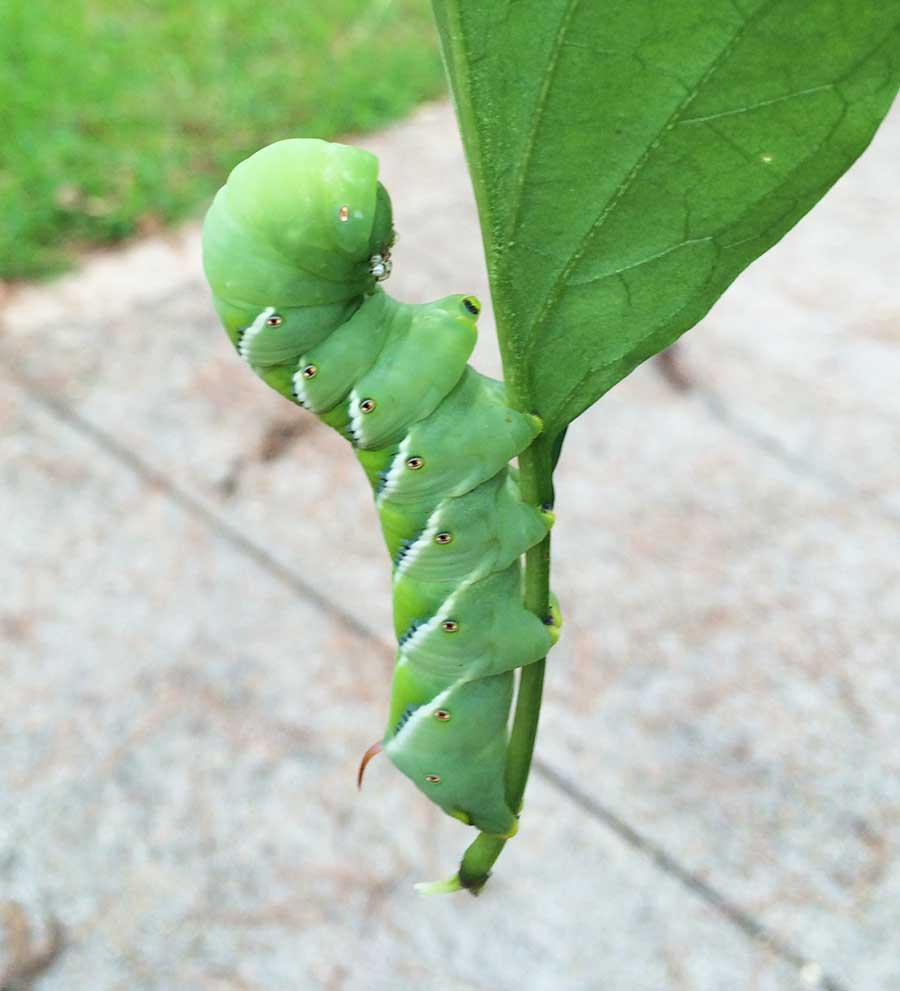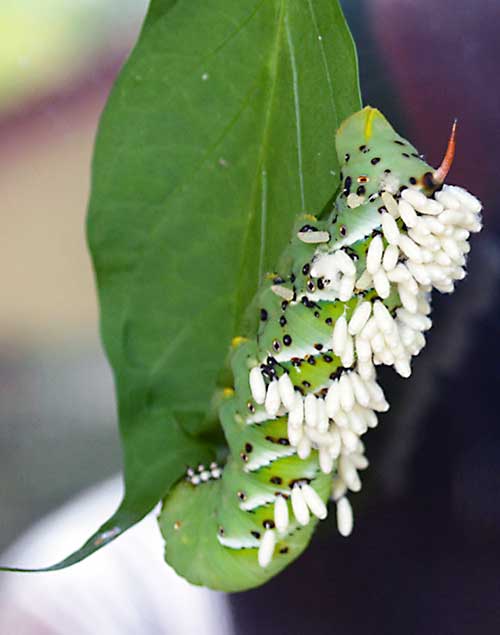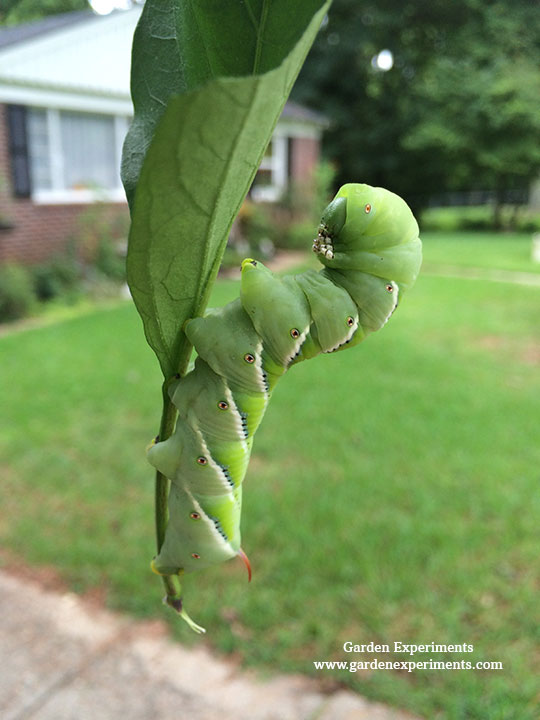
Have you discovered that something is eating the leaves of your tomato plants and damaging your green tomatoes? You probably have a tomato hornworm or a tobacco hornworm. If you look around, you will probably find a giant green caterpillar on your tomato plants.
What Does a Tomato Hornworm or Tobacco Hornworm Look Like?
These big worms can grow up to just over three inches in length and they are quite thick.
Both caterpillars have diagonal white stripes on their bodies and several small eyespot-like dots at the base of the stripes. The stripes on the tomato hornworm are edged in green and sometimes look like a v-shape; whereas the stripes of the tobacco hornworm are edged on one side in black (Source: University of Florida Entomology and Nematology Department).
Both the tomato and tobacco hornworm have a ‘horn’ on the last section of their abdomen. This horn looks a bit like a thorn or a spike. The thorn on the tomato hornworm is black; the horn on the tobacco hornworm is red.
The video below from the North Carolina Small Fruit and Tobacco IPM shows the physical differences between the two species of hornworm:
These large green caterpillars are the larval stage of a sphinx moth. The tomato hornworm (Manduca quinquemaculata) turns into a large brown sphinx moth, also known as a five-spotted hawkmoth.
The tobacco hornworm (Manduca sexta) also turns into a large brown moth. It is commonly called a hawkmoth, a Carolina sphinx moth, or hummingbird moth.
According to the University of Florida Entomology and Nematology Department, while both hornworms can be found throughout the United States, the tomato hornworm is not common in the Southeast. So, if you’re a gardener in my neck of the woods and you find a green caterpillar eating your tomato plant, it is likely the tobacco hornworm.
How Do Hornworms Get on My Tomato Plants?
Adult sphinx moths will lay eggs on plants in early spring. The hornworm caterpillar will begin to feed after hatching in a few days to one week.
The caterpillars feed for several weeks (they are voracious eaters – I have seen one worm strip an entire tomato plant) before creating cocoons (pupal stage). They will stay in the cocoons all winter.
Most of the early life stages of this insect are spent on host plants like tomatoes and peppers. When they are ready to pupate, the hornworms go underground to build their cocoons.
In the spring, the moths will emerge and start the process all over again.
How Do You Know if You Have a Tomato Hornworm or Tobacco Hornworm?
The Telltale Signs of Hornworms
The large green caterpillars that eat tomato plants and pepper plants are very well camouflaged. They blend in so well with the leaves of the plants they eat that you might have difficulty spotting them.
Here are a few signs that you may have tomato hornworms or tobacco hornworms:
- The leaves, stems, and fruit of the plant have obvious signs of being chewed on
- The top leaves of the plant are nearly stripped off entirely. These top leaves are new growth, which is easier to digest and eat.
- There are droppings on the leaves and ground around the plant. The droppings of these hornworms is very unique and looks a bit like a tiny green or black capsule divided into 6 sections.
The caterpillars are green which is excellent camouflage, so check the underside of your leaves carefully to find them. I often look for leaves that are stuck together or drooping in an unusual way. The weight of these caterpillars will often give them away.
However, I often find these critters eating my tomatoes and flowers by seeing their droppings first, then carefully checking my plants.
How to Get Rid of Tomato & Tobacco Hornworms
I don’t use chemicals in my garden if I can help it. When I find a tobacco hornworm on my tomato plants or pepper plants, I pick them off of the plant and toss them on the driveway for some lucky bird to eat.
You’ll need to carefully and frequently inspect your plants for hornworms to make sure that you got all of these garden pests. These green caterpillars are amazingly well camouflaged.
Tilling the soil where you plant tomatoes and peppers each year will destroy the hornworm cocoons. These large caterpillars make their cocoons in the soil, so this will kill them before they have a chance to emerge and lay eggs on more plants.
Here are some recommendations for organically managing tomato hornworms from MIGardener:
Tomato & Tobacco Hornworm Parasites
Have you seen a tomato hornworm that has tubular white spikes or sacks sticking on its back and sides? A hornworm that looks like the one below has been parasitized by the larvae of a wasp. The white spikes or sacs clustered on the back of the hornworm are the cocoons of a braconid wasp.
The wasp lays eggs under the skin of a hornworm and as the eggs hatch, the wasp larvae feed on the hornworm’s insides.

As the wasp larvae mature, they tunnel their way out of the body of the hornworm and build white tubular cocoons on the surface of the hornworm.
The larvae will eventually kill the hornworm as so many of them feed on the caterpillar’s insides. These wasp larvae are nature’s pest control for the big green hornworm caterpillars.
What Do Tomato and Tobacco Hornworms Eat?
These giant caterpillars feed on plants in the nightshade family which includes tomatoes, peppers, tobacco, eggplants, and potatoes.
They can also be found on some flowering plants and weeds, such as jimsonweed.
I found this large green caterpillar of the tobacco hornworm feeding on my jalapeno peppers in my garden.

Most gardeners are familiar with tobacco hornworms and tomato hornworms as the voracious eater of tomato plants. It’s a sad thing to go out to your tomato patch to find that the tomato you were waiting to pick has a large chunk missing from it.
